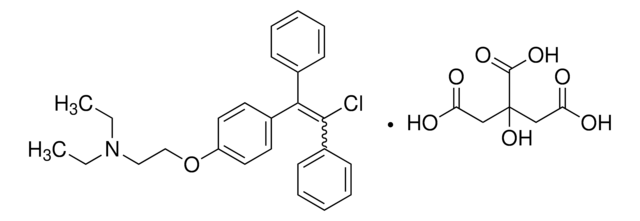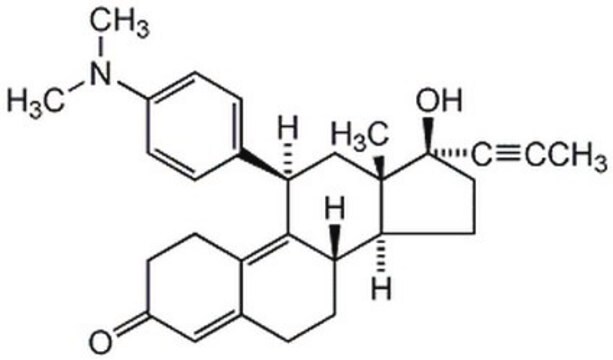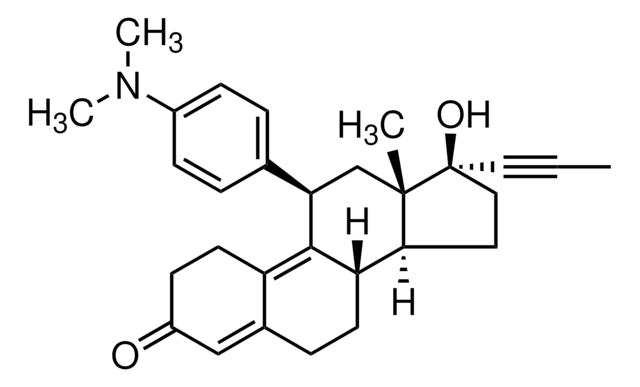SML0719
Enclomiphene hydrochloride
≥96% (HPLC)
동의어(들):
(E)-Clomiphene hydrochloride, 2-[4-[(1E)-2-Chloro-1,2-diphenylethenyl]phenoxy]-N,N-diethyl-ethanamine hydrochloride, 2-[p-(2-Chloro-trans-1,2-diphenylvinyl)phenoxy]triethylamine hydrochloride, ICI 46476, trans-Clomifene hydrochloride, trans-Clomiphene hydrochloride
로그인조직 및 계약 가격 보기
모든 사진(1)
About This Item
실험식(Hill 표기법):
C26H28ClNO · HCl
CAS Number:
Molecular Weight:
442.42
UNSPSC 코드:
51111800
NACRES:
NA.77
추천 제품
Quality Level
분석
≥96% (HPLC)
양식
powder
저장 조건
protect from light
색상
white to beige
solubility
H2O: 10 mg/mL, clear
저장 온도
2-8°C
SMILES string
Cl\C(=C(\c3ccc(cc3)OCCN(CC)CC)/c2ccccc2)\c1ccccc1.Cl
InChI
1S/C26H28ClNO.ClH/c1-3-28(4-2)19-20-29-24-17-15-22(16-18-24)25(21-11-7-5-8-12-21)26(27)23-13-9-6-10-14-23;/h5-18H,3-4,19-20H2,1-2H3;1H/b26-25+;
InChI key
KKBZGZWPJGOGJF-BTKVJIOYSA-N
생화학적/생리학적 작용
Enclomiphene is a non-steroidal estrogen receptor antagonist that promotes gonadotropin-dependent testosterone secretion by the testes.
Enclomiphene is a non-steroidal estrogen receptor antagonist that promotes gonadotropin-dependent testosterone secretion by the testes. Enclomiphene is the trans-isomer of clomiphene, which is about a 60-40 mix of trans (Enclomiphene) and cis (Zuclomiphene). While enclomiphene (trans-clomiphene) is an estrogen antagonist, zuclomiphene (cis-clomiphene) is a mixed agonist, responsible for the estrogenic activity and therefore the common side effects sometimes seen in males. The enclomiphene isomer is responsible for the anti-estrogen activity and the restoration of ones hypothalamic–pituitary–gonadal axis. In recent clinical trials, enclomiphene increased serum LH and FSH with concomitant increases in testosterone in men with secondary hypogonadism. Enclomiphene showed overall better results than testosterone gels, which raise serum testosterone but can lower LH and FSH at the same time.
기타 정보
Light sensitive
Storage Class Code
11 - Combustible Solids
WGK
WGK 3
Flash Point (°F)
Not applicable
Flash Point (°C)
Not applicable
가장 최신 버전 중 하나를 선택하세요:
A Ayaz et al.
Journal of medicine and life, 6(2), 199-201 (2013-08-02)
Polycystic ovary syndrome (PCOS) is the most common endocrinopathy in women and is associated with the reproductive and metabolic disorders. To compare the ovulation and conception rates after the treatment with Clomiphene Citrate (CC) alone and in combination with metformin
Serkan Yilmaz et al.
Mutation research. Genetic toxicology and environmental mutagenesis, 759, 21-27 (2013-11-06)
Clomiphene citrate (CC) is a selective estrogen-receptor modulator that is primarily used to enhance follicular development in women receiving in vitro fertilization (IVF) treatment. Although some studies suggested large increases in ovarian cancer risk related to fertility medications, this association
Marleen J Nahuis et al.
BMC women's health, 13, 42-42 (2013-10-29)
Clomiphene citrate (CC) is first line treatment in women with World Health Organization (WHO) type II anovulation and polycystic ovary syndrome (PCOS). Whereas 60% to 85% of these women will ovulate on CC, only about one half will have conceived
Fertility and sterility, 100(2), 341-348 (2013-07-03)
This committee opinion describes the use of clomiphene citrate, including indications, use, monitoring, and side effects. There is also a discussion of adjuvants and alternatives to clomiphene citrate therapy.
Akmal El-Mazny et al.
Gynecological endocrinology : the official journal of the International Society of Gynecological Endocrinology, 29(9), 826-829 (2013-07-17)
To evaluate the ability of a combination of multiple ovarian reserve markers to predict ovarian stimulation response in polycystic ovary syndrome (PCOS). On cycle Day 3 of 75 infertile patients with PCOS, serum follicle stimulating hormone (FSH), luteinizing hormone (LH)
자사의 과학자팀은 생명 과학, 재료 과학, 화학 합성, 크로마토그래피, 분석 및 기타 많은 영역을 포함한 모든 과학 분야에 경험이 있습니다..
고객지원팀으로 연락바랍니다.






